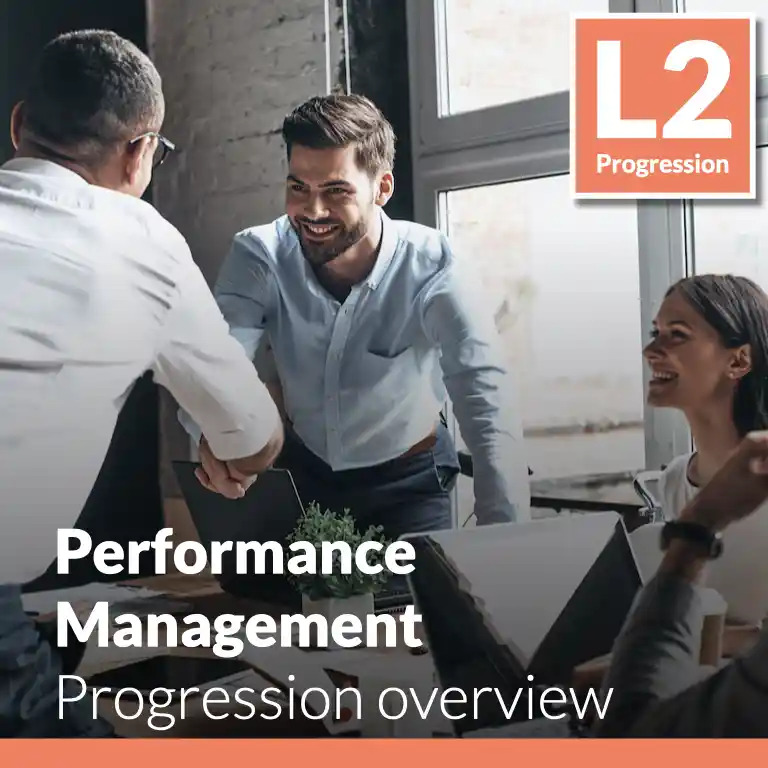Enjoy instant access to a scalable system of proven practices and execution-ready tools. Built to launch strategic HR programs 5X faster!
✓ Enjoy platform access
✓ Create your HR roadmap
✓ View open content in library
✓ Access dozens of practices:
⤷ The HR Strategy program
⤷ Explainers and deep dives
⤷ Supplemental guides
⤷ Insight articles
⤷ Weekly best practices
⤷ And more!
100% Free. No credit card required.
This guide is part of a progression set comprised of Core, Advanced, and Emerging Performance Management practices.
Performance Management at this level is both a strategy and a process deliberately designed to drive employee work efforts and behaviors in synch with the strategies and priorities of the larger business. It is based on an agreed-upon philosophy from which the process flows, with managers and employees acting in concert to create a culture of performance that matches the company's vision of how it will operate and accomplish its goals. It establishes formal links between larger organizational goals and those of the individual through a flow-down process designed to help employees translate those enterprise goals into their own.
Performance management brings a sharper focus on the performance of tasks and the achievement of work goals. It introduces more frequent work discussions, evolving from pure feedback into ongoing coaching and development conversations. This shift ensures that employees receive continuous support and development, enhancing their performance. It also separates other traditional considerations, such as career development and annual pay increases/bonus payments, out of their respective processes. While it remains integrated with both of those HR processes, career planning, and pay decisions are given their own space and timeframes to ensure that appropriate levels of energy and effort can be placed on each.
Advanced performance management is designed to create a stronger alignment between individual goals and those of the department, function, business unit, and company. It can positively impact employee engagement, where individuals enjoy a clearer “line-of-sight” between their work and that of the broader organization. This increases the sense of connection to the company and its objectives, leading to a significantly enhanced sense of work/role meaningfulness that research conforms leads to increased engagement, motivation, and retention. It also promises to create a high-performance culture through coaching support being delivered weekly or bi-weekly while the work is underway rather than waiting until the end of the year to provide feedback that cannot be acted on until the following performance year. Employees are given the opportunity to adjust their work behaviors and efforts with skills development and enhancement occurring throughout the year. This can lead to increased alignment of employee and manager perceptions of their contributions and guide them in better (and more precisely) determining development needs and opportunities.
It helps build more robust and constructive employee-manager relationships through frequent conversations and a clearer understanding of an employee’s development goals and aspirations. It also provides more time and attention for planning and developing an employee’s skills and careers and the equitable distribution of rewards and recognition, both of which are drivers of employee retention and engagement. It creates a more meaningful opportunity to discuss career options and ambitions outside of the often stressful performance review by focusing on that as a separate and longer-term focus instead of only in the context of the past year’s performance. Similarly, compensation discussions can become one with a longer view into the aggregated contributions and most appropriate positioning as opposed to only the past year.
Adopting these practices establishes a clear strategic positioning of performance management as a driver of management style and a guide for how employees will be guided in the performance of their roles. It creates a powerful alignment of goals between employees at all levels, such that those at the lowest levels can more clearly see and articulate how their primary objectives are linked and contribute to achieving those of the top leaders and the larger organization. It develops a rhythm of more frequent conversations between employees and their managers, where performance challenges can be identified and corrected early through constructive guidance and support, goal and task priorities can be adjusted as needed, and opportunities for significant achievements can be identified more readily. All of those possibilities are collected, verified, and documented throughout the year to establish a more accurate performance record. More formalized and structured discussions related to compensation and development are held. These take on a longer-term focus that provides improved context and understanding, confirming that compensation and development are driven by long-term value to the organization and not solely connected to annual performance.
A philosophy clarifies the purpose and envisioned value of performance management, defining how the company wants to lead and manage its people.
Creating a formal flow of goals from top executives down to the lowest level employees ensures an alignment of work efforts and objectives across all levels of the organization.
Providing feedback and guidance on an ongoing basis to help employees improve how they conduct work and achieve outcomes.
Focusing on performance planning, tracking, assessment, development, coaching, and feedback to link the integral benefits to employees of the performance management process.

Enjoy instant access to a scalable system of proven practices and execution-ready tools. Built to launch strategic HR programs 5X faster!